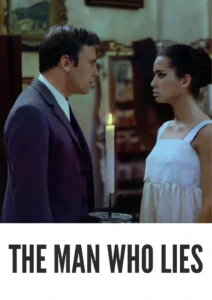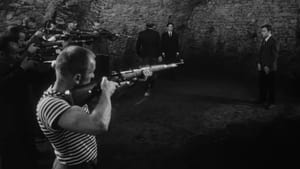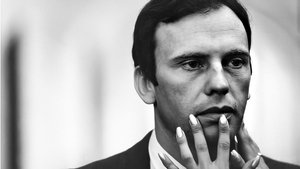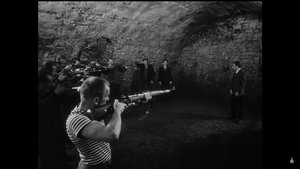Contact: [email protected]
Video Sources 0 Views

Synopsis
The Man Who Lies 1968: A Surreal Journey Through Truth and Deception

Introduction
In the annals of cinema history, few films stand out as boldly enigmatic as “The Man Who Lies 1968.” This article embarks on a surreal journey through the film’s labyrinthine narrative, existential themes, and enduring impact. As we delve into the murky depths of truth and deception, we uncover the significance of its early colored films version and its timeless relevance.
Check The Full Colorized Movies List
Check Our Colorized Movies Trailer Channel
The Artistry of “The Man Who Lies”
Alain Robbe-Grillet’s Vision
At the helm of “The Man Who Lies” is the visionary French filmmaker Alain Robbe-Grillet, renowned for his exploration of narrative ambiguity and psychological complexity. With a cast led by Jean-Louis Trintignant as the enigmatic protagonist, Robbe-Grillet crafts a cinematic puzzle that defies easy categorization. Trintignant’s performance is haunting and hypnotic, drawing viewers into a world where reality and illusion blur into one.
Surreal Cinematography
One of the most striking aspects of “The Man Who Lies” is its surreal cinematography, which captures the disorienting atmosphere of the film with breathtaking precision. Shot in stark black-and-white, the film evokes a sense of dreamlike unreality, immersing viewers in a world where nothing is as it seems. The decision to forego color adds to the film’s haunting aesthetic, amplifying its themes of identity, memory, and the nature of truth.
Revisiting the Storytelling Mastery: Plot and Themes
A Tale of Deception and Betrayal
“The Man Who Lies” follows the journey of a mysterious drifter who wanders through the war-torn landscapes of post-World War II Europe, spinning a web of lies and half-truths wherever he goes. As he navigates the treacherous terrain of memory and perception, he becomes embroiled in a series of increasingly surreal encounters that blur the line between reality and fantasy. Along the way, he confronts his own past and grapples with the elusive nature of truth.
Themes of Identity and Perception
Central to the film’s narrative are its themes of identity and perception, which are explored through the lens of the protagonist’s existential journey. As he wrestles with his own sense of self and grapples with the shifting sands of memory, he becomes increasingly entangled in a web of deceit and self-delusion. Through its enigmatic storytelling and labyrinthine plot, “The Man Who Lies” invites viewers to question the nature of reality and the boundaries of perception.
The Dynamic Relationship Between Truth and Deception
A Mind-Bending Exploration
At the heart of “The Man Who Lies” lies the dynamic relationship between truth and deception, reality and illusion. As the protagonist navigates the surreal landscape of his own mind, he becomes increasingly lost in a maze of conflicting narratives and shifting identities. Through his journey, the film explores the fragile nature of truth and the seductive allure of falsehood, leaving viewers questioning their own perceptions of reality.
A Visual and Technical Achievement
The Power of Black-and-White
Shot in stark black-and-white, “The Man Who Lies” is a visual tour de force that captures the haunting beauty of its surreal landscapes with breathtaking precision. Each frame is imbued with a sense of foreboding and mystery, inviting viewers to unravel the enigmatic puzzle at the heart of the film. The monochromatic palette adds to the film’s surreal atmosphere, enhancing its themes of ambiguity and uncertainty.
Early Colored Films Version
In a bold departure from convention, the filmmakers behind “The Man Who Lies” experimented with an early colored films version of the movie, offering audiences a new perspective on its surreal tale. This innovative approach to colorization adds depth and nuance to the film’s visuals, enriching its already mesmerizing aesthetic and enhancing the overall viewing experience.
Behind the Scenes of “The Man Who Lies”
Crafting a Cinematic Enigma
Behind the camera, Alain Robbe-Grillet and his team worked tirelessly to bring “The Man Who Lies” to life with authenticity and attention to detail. From the surreal set designs to the haunting musical score by Georges Delerue, every aspect of the production was designed to immerse viewers in a world of mystery and intrigue.
The Magic of Collaboration
One of the most remarkable aspects of “The Man Who Lies” is the collaborative spirit that infused every aspect of its creation. From the mesmerizing performances of the cast to the stunning cinematography and evocative score, each element of the film was brought to life through the collective efforts of a team dedicated to realizing Robbe-Grillet’s vision.
Legacy and Influence on Cinema
Critical Acclaim and Cult Status
Upon its release, “The Man Who Lies” received widespread critical acclaim, with particular praise for its surreal atmosphere, enigmatic storytelling, and haunting performances. Over the years, the film has garnered a devoted following among cinephiles and continues to be celebrated for its bold artistic vision and provocative themes.
Inspiring Future Generations
“The Man Who Lies” has left an indelible mark on the world of cinema, inspiring filmmakers and audiences alike to embrace the power of ambiguity and the beauty of uncertainty. Its enduring legacy serves as a testament to the enduring power of cinema to challenge, provoke, and inspire wonder.
Where to Watch “The Man Who Lies 1968 Full Movie”?
For those eager to experience the surreal beauty of “The Man Who Lies” in its entirety, the film is readily available on various streaming platforms and home video releases. Whether you’re a seasoned cinephile or a newcomer to the world of cinema, “The Man Who Lies” promises a journey unlike any other—a journey into the depths of the human psyche and back again.
In Conclusion
“The Man Who Lies 1968” stands as a surreal masterpiece—a testament to the power of cinema to challenge our perceptions and expand our horizons. With its enigmatic storytelling, haunting imagery, and provocative themes, “The Man Who Lies” continues to captivate audiences and inspire filmmakers to this day. As we revisit this cinematic enigma, let us marvel at its timeless beauty and reflect on the profound truths it holds for those brave enough to venture into its mysterious depths.













